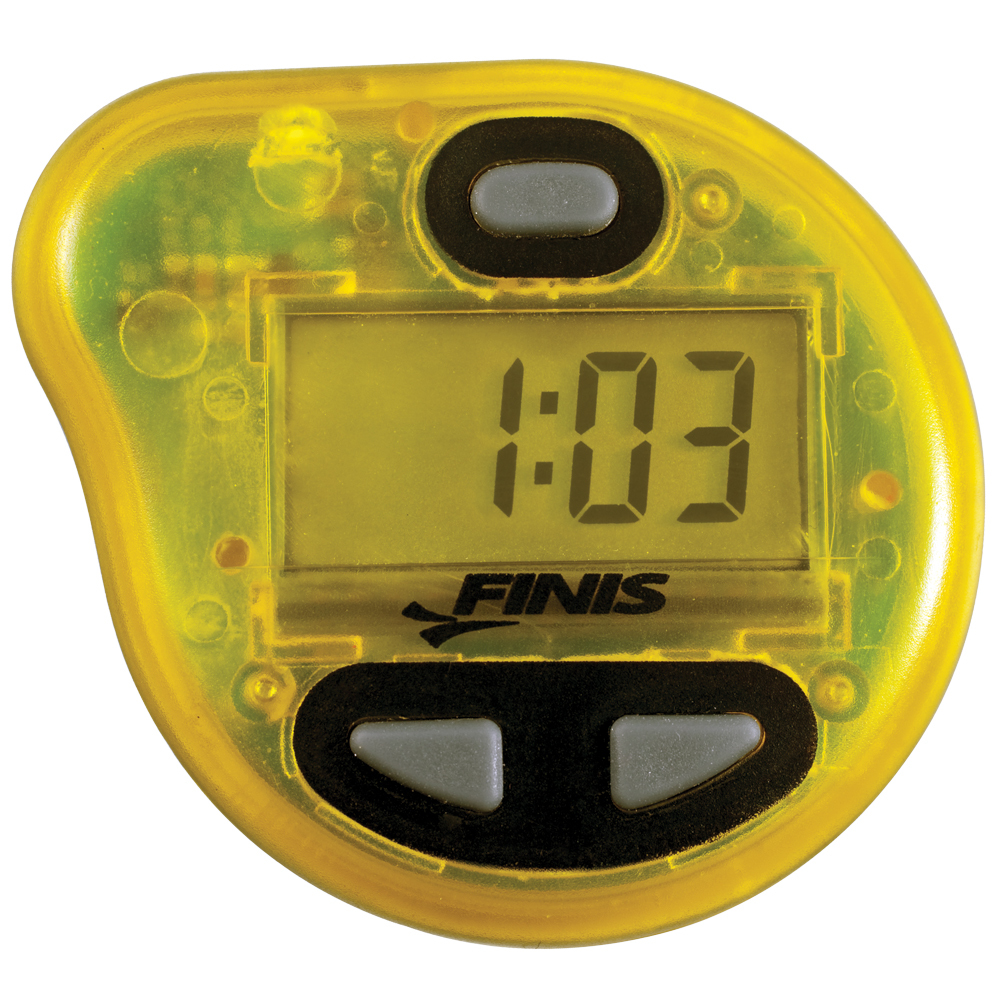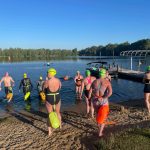
Swim to the Beat
I’m a minimalist when it comes to swimming equipment. I haven’t used buoys, paddles, kickboards or fins for 25 years. However, one tool – the Finis Tempo Trainer – has deepened my capacity for mindfulness, yielded priceless insights into my stroke and taught me to ‘encode’ pacing skills in my nervous system. The Tempo Trainer (TT) is a small electronic metronome you can tuck under your cap or clip to goggles. Here’s why I would choose the TT over any other timing device, including pace clock or sports watch:
1. It focuses you. Swimmers often leave one end of the pool thinking only about getting to the other end. The Tempo Trainer (set to beep at a frequency of, say, 1.2 seconds) transforms each lap into a series of 1.2-second intervals. You soon realize that each of those intervals is composed of ‘consequential nanoseconds’ within which you make or break the stroke you’re taking. You become far more attuned to subtle deviations in your stroke – and conscious it could cost you an extra stroke (and an extra 1.2 seconds) when you reach the other end. Those tiny errors are almost always the result of a moment’s inattention, providing powerful motivation to stay focused.
2. It improves rhythm. Consistent – even metronomic – rhythm is a central element of success in distance swimming. It’s also the quality that harmonises all parts of the stroke into a seamless whole.
3. It teaches unerring pace. Sense of pace (sometimes called ‘clock in the head’) is often thought to be a trait you’re born with – or acquire through endless repetition. The TT is a fast and reliable way to learn this critical skill. If Strokes Per Length (SPL) remains consistent as you keep pace with the beep, so does your pace.
4. It ‘cracks the code’ on speed. If you save a stroke while maintaining tempo, or increase tempo by a few hundredths of a second while maintaining stroke count, you swim faster. This quickly produces an awareness that any pace is the inevitable product of a particular SPL and Tempo; not of how fast – or hard – you stroke. This produces newfound confidence that you have control of how fast you swim.
5. It emphasises the benefits of training your brain. It’s eye-opening to discover how quickly your brain and nervous system can solve a pace or speed ‘problem’ in a thoughtfully-designed set (examples follow). You often experience striking efficiency gains in as little as 10 or 15 minutes – and make thrilling progress in the course of a week. You learn you can improve far more quickly when you focus on training the brain and nervous system than when you train limbs, lungs and muscles as in traditional training. Repeating high quality strokes at incrementally faster tempos over gradually greater distances will produce far more improvement than any other form of training.

Six Tasks to Practise with a Tempo Trainer
Experienced competitive swimmers can generally begin with a Tempo Setting between 1.0 and 1.10 sec/stroke. Newer swimmers should begin with a setting between 1.20 and 1.40 seconds.
Task #1 Explore Your Stroke
When using the TT, you synchronise the beep with a select moment in the stroke – most commonly the hand entry. Swim several 25 metres to familiarise with synchronising first hand entry with fourth beep. Pick a tempo that feels quite comfortable. Then try this set:
Swim 4 rounds of (3 x 25m). In Round 1, synchronise beep to hand entries. In Round 2, synchronise to hip movements (we call them hip ‘nudges’). In round 3, synchronise to feet (toe ‘flicks’). In round 4, you have two options: Ccycle through one 25m of each; or stay with your favourite.
Did you feel anything new or different as you moved synch point from hands to hips? When you synchronise beep to feet, for an effective two-beat kick, take note of any foot movements between beeps.
Task #2 Examine Your Breathing
Choose a comfortable tempo. Swim 4 rounds of (3 x 25m), as 25m breathe right, 25m breathe left, 25m bilateral. Do you notice any variation in your ability to stay with the beep as you change breathing side or pattern?
Task #3 Constant SPL and Tempo (means constant pace)
Swim 8 x [25m or 50m] @ ‘Tempo Sweet Spot.’ Rest 10 beeps between swims. Count strokes per 25m or 50m. Your first goal is to keep focus and SPL constant. If SPL is unchanged, your pace is steady. A great outcome is to reduce stroke count as a result of strong focus. This demonstrates that focus is usually the key to faster swims.
Task #4 Tempo Pyramid
This is my favorite set. This exercise – after many repeats over weeks or months – tells you your range of efficient SPL with complete precision.
Choose your most comfortable tempo from previous tasks as your starting point.
Swim 4 x 50m, slowing tempo by .06 (i.e. 1.20, 1.26, 1.32, 1.38) on each. Subtract as many strokes as possible while tempo slows.
Then swim 6 x 50m, increasing tempo by .03 (i.e. 1.35, 1.32, 1.29, 1.26, 1.23, 1.20). Try to maintain lower stroke counts for as many tempo changes as possible.
When you complete the set at your starting tempo, how many SPL did you ‘save?’ Multiply by tempo to calculate how many seconds you saved.
Task #5 Hold Pace; Lengthen Your Stroke
Swim a series of timed 50m or 100m. Set initial tempo at 1.2 seconds. Slow tempo by .01 each repeat (i.e. 1.21, 1.22, 1.23, etc.) For how many repeats can you maintain your initial pace or time? Each time you slow tempo slightly, you’ll have to lengthen your stroke slightly to maintain same time. Try to complete at least 8 x 100m without slowing.
Task #6 Maintain Stroke Length; Swim Faster
Set Tempo at Comfort Zone. Swim a series of 25m. Count strokes. Increase tempo by .01 each 25m. (i.e. 1.20, 1.19, 1.18, etc.) For how many 25s can you hold your initial stroke count? A good goal is to complete 8 x 25 (.07 sec increase in tempo) without adding a stroke to your count. Repeat this set regularly until you can do this.







